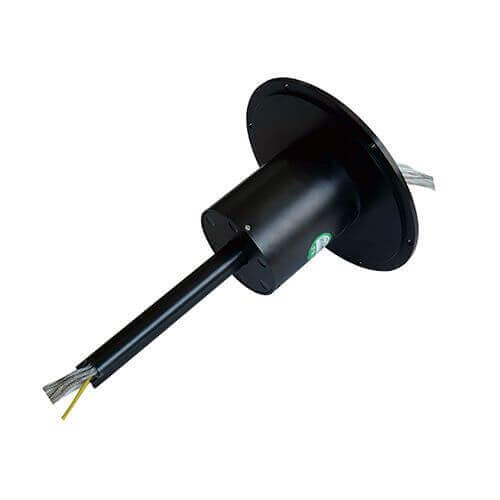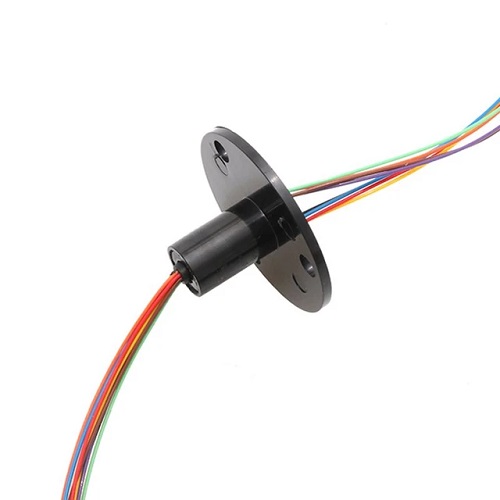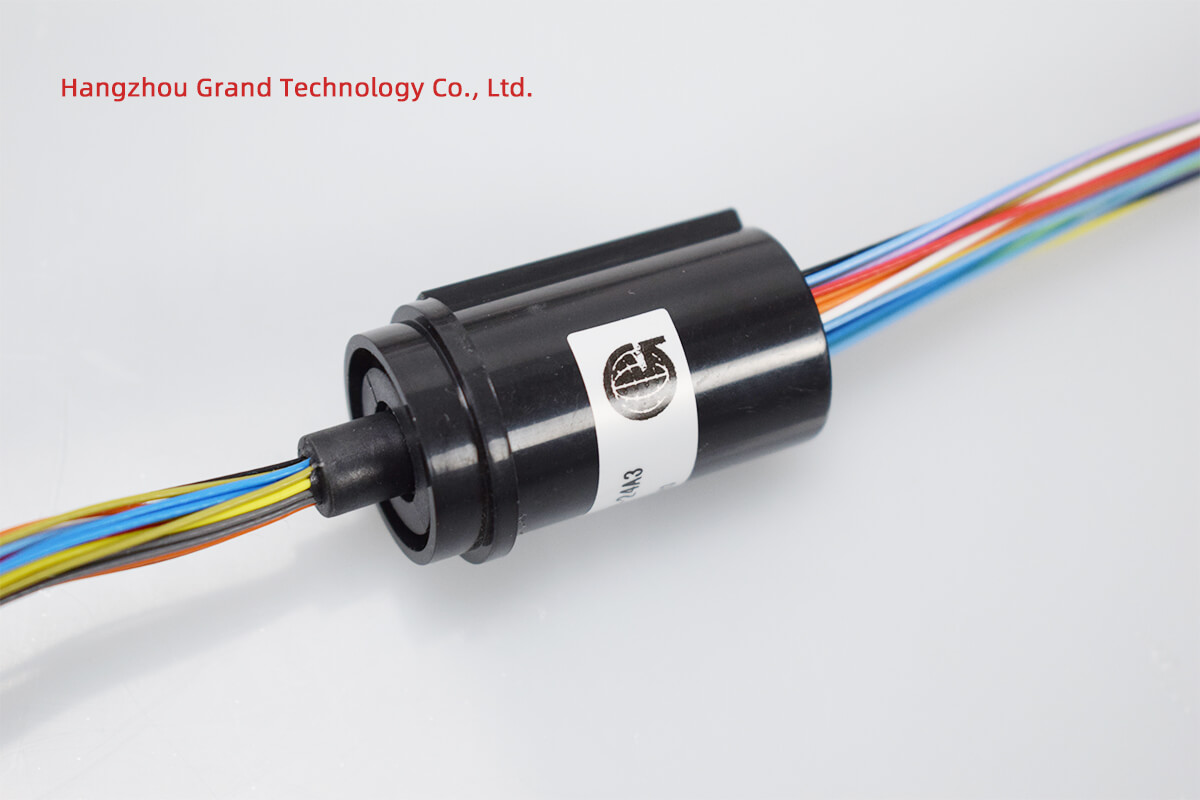A slip ring rotating connector is an electromechanical device that allows the transmission of electrical power and data signals between a stationary and a rotating component. This is made possible by continuous unbroken contact between the brushes (usually made of metal or graphite) and the concentric conductive rings attached to the rotating assembly. Essentially, it serves as a crucial element in providing a vital connection where uninterrupted power supply is required in systems with rotating parts.
The importance of slip ring rotating connectors cannot be overstated, as they have found widespread use in an extensive range of industries and applications. Industries such as renewable energy, aerospace, defense, automation, medical, marine, telecommunications, and many more rely on these connectors to enable smooth, uninterrupted operations in their equipment and machinery. The versatility of slip ring rotating connectors has given engineers the ability to design and develop advanced systems that incorporate rotating apparatus without sacrificing the ability to maintain stable power and data connections. Their critical function in a vast range of systems has led to the development of various designs and configurations, tailored to meet the diverse requirements of different sectors and applications.
Slip Ring Rotating Connector Design and Functionality
The design of slip ring rotating connectors varies based on the demand of different applications, but all share the core elements required for their primary function – to transfer current or signals from a stationary structure to a rotating one. The basic design possesses a rotating assembly, comprising a conductive ring attached to the rotating unit, and a stationary assembly formed by brushes that maintains contact with the conductive ring. The brushes and the rotating conductive ring work together to enable the transfer of electric power or signals while ensuring a continuous 360-degree rotation, underpinning the fundamental functionality of these connectors.
The operating principle behind a slip ring rotating connector is rather simple yet ingenious. When the device is in action, the stationary brush contacts the rotating ring, creating an electrical connection. As the ring rotates, it facilitates the transfer of power and data from the stationary to the rotating structure. This seemingly straightforward process involves consideration of many factors, such as minimizing friction to avoid overheating, preventing loss of connection due to bounce, and ensuring durability under diverse operational conditions.
The diverse demands of various industries have given rise to different types of slip rings with unique features, benefits, and drawbacks. Among these, the capsule slip ring and the pancake slip ring are recognition-worthy.

Capsule slip rings are compact and cylindrical, designed for use in confined spaces. This compactness does not compromise their circuit capacity, as good quality capsule slip rings can support a significant number of circuits, making them ideal for data and signal transmission in miniaturized rotating devices.
On the other hand, pancake slip rings are flat and disc-shaped, designed for equipment where height is a constraint but diameter is not as critical. The conductive rings are arranged along the rotation axis in these slip rings, offering a distinct structure from their cylindrical counterparts.

These distinct slip ring types, along with others, allow for a broad range of applications while achieving the primary goal of seamless power and data transfer across stationary and rotating systems.

Slip Ring Rotating Connector Key Features and Specifications
A slip ring rotating connector’s performance and suitability for a particular application rely heavily on its key features and specifications. Understanding these attributes can help users make an informed decision when choosing the right connector for their needs.
- Number of circuits: The number of circuits a slip ring can accommodate determines how many simultaneous channels of electrical power, data, or signals can be transmitted. This is an essential aspect to evaluate based on the intended application’s complexity and requirements. Some slip rings can support only a few circuits, whereas others can accommodate dozens, making them ideal for high-density data transmissions.
- Voltage and current ratings: The voltage and current ratings demonstrate the maximum electrical power and current that can be safely carried by the slip ring without causing damage. Different applications demand power supplies with varied voltage and current levels, making it essential to select a connector that is compatible with the specific requirements of the target system.
- Operating speed: The operating speed of a slip ring indicates the device’s maximum rotational speed so that it can safely function without encountering any issues. Exceeding this speed may pose risks to the slip ring’s integrity, leading to rapid wear and potential failure. Selecting a slip ring with an appropriate operating speed range is critical for ensuring the device’s reliability in the long run, particularly in high-speed rotating environments.
- Material types: The materials used in slip ring rotary connectors play a vital role in their performance and longevity. The brush and the conductive ring materials must ensure low friction, minimal wear, good conductivity, and optimal resistance to temperature fluctuations. Common materials used include gold, silver, copper, and graphite, each with its distinct advantages and disadvantages.
The performance of a slip ring rotating connector is greatly influenced by the combination of these features and specifications. For instance, selecting a connector with the right number of circuits, compatible voltage, and current ratings, suitable operating speed range, and optimal materials directly impacts not only the efficiency of power and data transfer but also the maintenance intervals and long-term reliability.
It is essential to thoroughly analyze these attributes and align them with the intended application to ensure the ideal balance of seamless operation, durability, and performance for the given context.
Slip Ring Rotating Connector Applications and Industry Usage
The versatility of slip ring rotating connectors has enabled them to be widely used in numerous industries, supporting seamless rotation while maintaining electrical and communication connections with high efficiency. Their applications span various equipment, systems, and devices, with some of the most common examples being wind turbines, cable reels, test equipment, and rotary sensors. The adaptability and reliability of these connectors have made them indispensable across various sectors, each leveraging their capabilities in unique ways.
- Wind turbines: In wind energy generation, a wind turbine’s rotor captures kinetic energy from air movement and converts it to electrical energy to be supplied to the power grid. Within these turbines, slip ring rotating connectors are used to transfer generated electricity from the rotating nacelle to the stationary tower structure. The reliable transfer of electricity without any loss or interruption is integral to the overall efficiency of the wind turbine.
- Cable reels: Cable reels are found in diverse industries, from construction and mining to firefighting and waste management. These reels support the deployment and retraction of continuous lengths of electrical, hydraulic, or pneumatic cables or hoses. Slip ring rotating connectors ensure smooth power and signal transmission between the stationary base and the rotating reel, without tangling, twisting, or snapping the cables.
- Test equipment: In manufacturing processes and quality assurance workflows, test equipment employing rotary platforms or stages is often used for the evaluation of physical properties, performance, and reliability. Slip ring connectors play a crucial role as a central point of communication between test equipment and the rotating samples, maintaining electrical connections without hindering rotation.
- Rotary sensors: Rotary sensors find widespread applications in the automotive, aerospace, and robotics industries, among others, to measure angular or rotational motion. In such sensors, slip ring rotating connectors provide a dynamic interface for continuous data transmission or signal exchange between the rotary component and the stationary sensor subsystems.
Case study example:
- Satellite communication systems: In the field of satellite communication, ground antennas must constantly adjust their orientations to maintain a continuous line-of-sight link with the satellite. Slip rings are employed within the antenna positioning machinery, enabling smooth rotational motion while ensuring uninterrupted communication and electrical paths. The durability of these slip ring connectors becomes critical as they must withstand harsh outdoor environments and perform reliably throughout a wide range of weather conditions.
These examples illustrate the diverse range of applications and industries that leverage the slip ring rotating connectors’ versatility and ability to transmit power and data seamlessly, ensuring uninterrupted function in a vast array of rotating systems and equipment.
Key Concerns When Choosing Slip Ring Rotating Connectors
As valuable as slip ring rotating connectors are in facilitating electrical power and signal transfer in systems with rotating parts, the selection process can be daunting. It is essential to carefully consider several factors when choosing the right device for a specific application.
- Operational Environment: The environment in which a slip ring is expected to function can have a significant impact on its operational lifespan and overall performance. Locations exposed to extreme temperatures, moisture, dust, corrosive substances, and excessive vibrations demand slip rings designed with materials and construction methods that can withstand these harsh conditions.
- Required Life Span: The expected operational life span of a slip ring plays a critical role in its selection. For systems that demand long-term, uninterrupted operation (like renewable energy devices), high-end slip rings with low wear and long-life contacts, such as gold or silver, are necessary despite their higher associated costs.
- Rotation Speed: Different applications demand a varied range of rotation speeds. It’s important to consider the maximum rotation speed that the slip ring can safely sustain without issues. Using a slip ring beyond its rated speed can lead to failures and decreased life expectancy.
- Specific Application Requirements: Lastly, the requirements of the particular application must be thoroughly understood. Different requirements call for variations in a number of circuits, voltage, and current ratings, data transmission rates, and more.
In the day-to-day use of slip ring rotating connectors, several challenges may arise.
- Wear and Tear is one of the most common issues faced by users. With slip rings, wear can lead to degraded performance over time, affecting the quality of signal and power transmission. Periodic maintenance and replacement is often necessary to prevent this.
- Signal Interference can also pose a significant problem. Poor data transmission or power losses can occur due to signal noise or electromagnetic interference, which reduces the operational efficiency of the slip ring.
- Maintenance Challenges arise from the need for regular cleaning or replacement of components to ensure smooth operations. This can end up being costly and time-consuming and could lead to system downtime.
- Environmental Factors, such as temperature fluctuations, humidity, dust, or corrosive substances, can also affect the performance and longevity of the slip ring connectors.
In conclusion, while the utility of slip ring rotating connectors is undeniable, users must carefully evaluate their specific needs against the features, specifications, and potential issues associated with different models to select the most reliable and efficient connector for their application.
Slip Ring Rotating Connector Main Manufacturers and Comparison
The market for slip ring rotating connectors is replete with options, with several leading manufacturers offering a diverse range of products suitable for various applications. Here, we introduce some notable manufacturers and compare them based on product range, customization capabilities, pricing, and customer reviews.
- Hangzhou Grand Technology: Hangzhou Grand Technology is another leading manufacturer of slip rings, with extensive experience in the research and development of high-quality products. Their offerings range from miniature slip rings and high-frequency slip rings to Ethernet and fiber optic slip rings, catering to various fields such as renewable energy, robotics, and satellite communication. With competitive pricing and a good reputation for customization, Hangzhou Grand Technology is widely appreciated by customers for its strong technical support and reliable products.
- Senring: Senring is a reputable global manufacturer of slip ring connectors, offering a comprehensive range of products for different industries and applications. Their portfolio includes capsule slip rings, through-hole slip rings, separate slip rings, and more. Senring’s dedication to innovation, quality, and customization capabilities has earned them favorable customer reviews. Although their pricing might be on the higher side, the quality and performance of their products typically justify the cost.
- Moflon: Moflon is a well-established manufacturer, specializing in high-performance slip ring connectors since the 1980s. Their product range comprises standard and custom slip rings in various forms, such as capsule, through-bore, pancake, and customized units, along with additional offerings like fiber optic rotary joints. Moflon is known for its technical expertise, responsive customer support, and competitive pricing, making it a popular choice among customers. However, it is important to review the specifications of the products carefully to ensure they are compatible with the intended application.
- Stemmann-Technik: Stemmann-Technik is a renowned global supplier of energy transmission and data communication systems, with a comprehensive array of slip ring rotating connectors in their portfolio. Their specialized products cater to industries such as crane technology, wind energy, material handling, and more. Although Stemmann-Technik’s products offer exceptional quality and reliability, their pricing might not appeal to budget-conscious customers, making them a premium choice for those seeking high-end performance and durability.
In conclusion, the ideal slip ring rotating connector manufacturer depends on the specific requirements of the application, budget constraints, and customer preferences. Comparing these leading manufacturers based on product range, customization capabilities, pricing, and customer reviews can help users make an informed decision on the most suitable provider for their needs.
Slip Ring Rotating Connector Maintenance and Troubleshooting
Proper maintenance and troubleshooting protocols are essential for optimizing the performance and extending the lifespan of slip ring rotating connectors. While these devices are engineered to deliver reliable operations, their performance can degrade over time without regular maintenance and troubleshooting.
Maintenance Tips and Advice
- Regular Inspection: Frequent inspection is a key aspect of maintenance. This includes checking for any signs of wear, corrosion, dirt accumulation, or other damage that could affect performance.
- Cleanliness: Ensuring the cleanliness of the connectors is crucial. Dust, corrosion, or other contaminants can lead to increased wear and tear, impacting the efficiency and longevity of the slip ring. Cleaning products compatible with electrical components are recommended for this purpose.
- Lubrication: The moving parts of the slip ring should be routinely lubricated to minimize friction, thereby reducing wear and tear. Make sure to use lubricants compatible with the materials used in the slip ring.
- Replacement of Worn-Out Parts: Components such as brushes and contact rings may degrade over time and require replacement. Regular inspection can help identify such components before they lead to failures.
Troubleshooting Techniques
When problems do arise, effective troubleshooting can help identify and rectify the issues promptly. Here are some common problems and the corresponding solutions:
- Intermittent Functioning: This issue is often due to broken wires or loose connections. Ensure that all connections are secure, and if required, replace any damaged cables or connectors.
- Poor Signal Quality: This can be due to dust or corrosion on the contact surfaces. Cleaning the surfaces can rectify this issue; however, if the problem persists, consider replacing the brush or contact ring.
- General Performance Degradation: Overheating, excessive noise, or vibration could signal wear and tear or alignment issues. Check for worn-out parts, realign any misaligned components, or consult a professional if the issue persists.
- Electrical Noise or Interference: Issues like signal noise can occur due to electromagnetic interference or inadequate grounding. Checking the grounding connections and possibly adding shielding might help combat this issue.
In conclusion, ensuring the longevity and effective performance of a slip ring rotating connector requires diligent maintenance and troubleshooting. By understanding the potential issues and knowing how they can be rectified, users can maximize the operational lifespan of their connectors.
The Future of Slip Ring Rotating Connectors
Slip ring rotating connectors have played a vital role in electrical systems and their applications continue to grow. Their future holds exciting potential, with research and development in the field focused on addressing current limitations and pushing boundaries. Here are some of the upcoming trends and advancements anticipated in the world of slip ring rotating connectors.
- Advancements in Material Science Leading to Longer Lifespan: The science behind material selection for slip ring connectors is advancing, with new developments focused on increasing lifespan and improving performance. For instance, alloys of gold, silver, and other precious metals are being explored to limit wear from friction in operating slip rings. The use of these materials could significantly decrease maintenance needs, reduce system downtime, and increase overall efficiency.
- Advanced Designs for Improved Efficiency: Directly linked with advances in material science are new and innovative designs focused on enhancing the efficiency of slip ring connectors. This includes smaller, more compact designs for applications with limited space, as well as designs for high-speed or high-frequency applications. Such advancements aim to meet the growing demands of sectors such as renewable energy, robotics, and aerospace.
- Market Growth Projections: The slip ring market is anticipated to witness significant growth in the coming years. This is largely due to the increasing demand across various industries, such as communication, defense, industrial automation, and especially renewable energy, where wind power generation heavily relies on rotating connectors for efficient energy transmission.
Furthermore, technological advancements in rising sectors like electric vehicles and drones will potentially expand the demand for novel slip ring connectors, thus propelling both technological progression and market growth.
In conclusion, the future course of slip ring rotating connectors is bound to be marked by sophistication and growth. Technological developments, combined with market demand, will evolve the slip ring industry, driving the creation of connectors that offer more durable, efficient, and reliable solutions for a wider range of applications.
Conclusion
Despite their modest size, slip ring rotating connectors bear weighty responsibility, ensuring seamless power and data transmission across various key industries. When chosen and maintained mindfully, they can deliver unmatched value, propelling operational efficiency to unprecedented heights.
See What We Can Do

